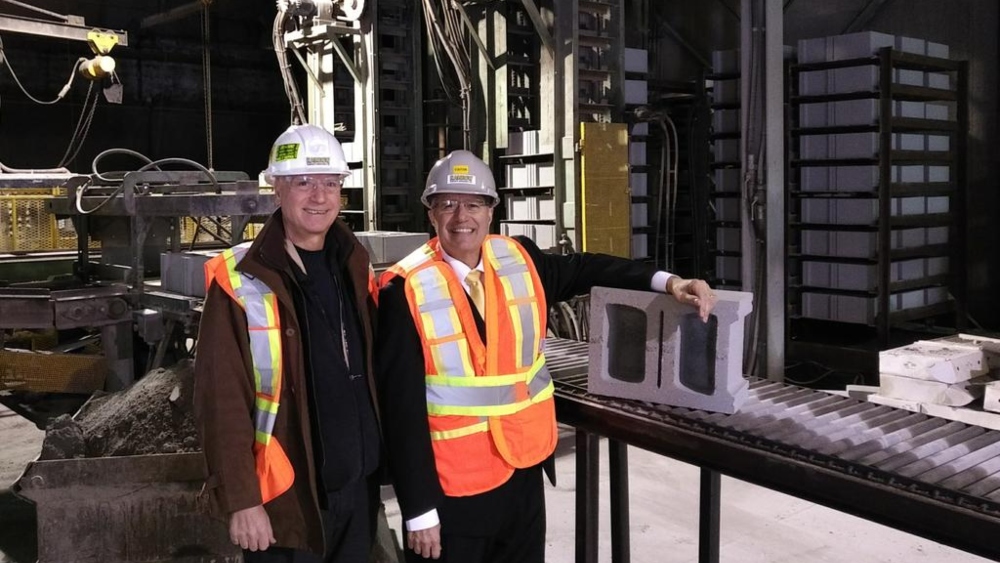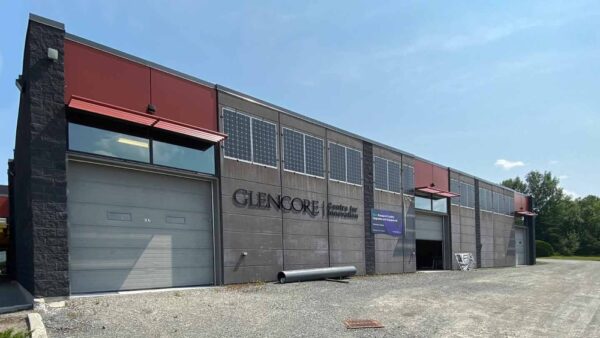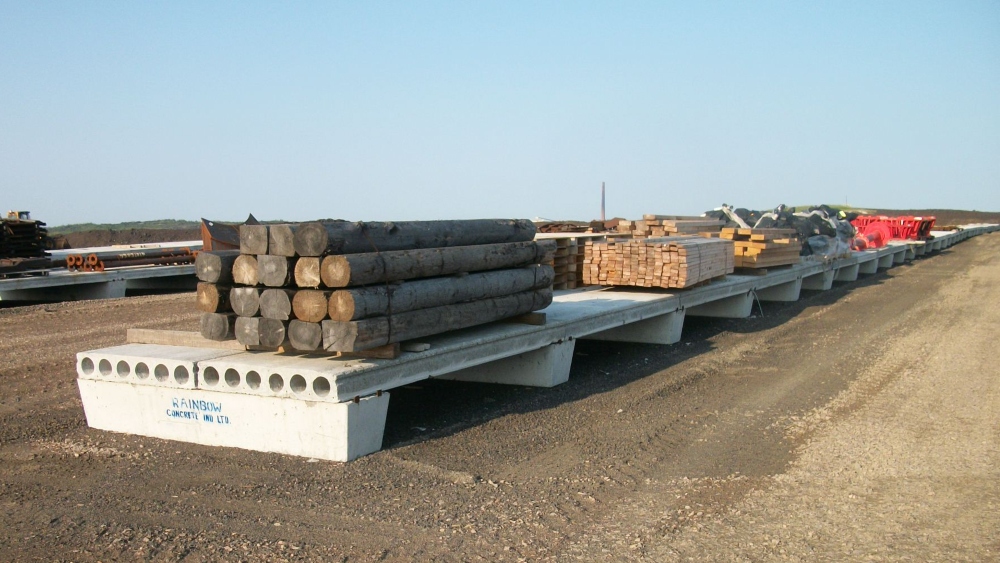By Lisa McIvor, MineConnect Staff
Rainbow Concrete Industries is a family-owned, Canadian business which was founded by Bulgarian immigrant, the late Nick Naneff, 70 years ago. Through hard work, dedication to the needs of their customers, imagination, foresight and skill, Nick, along with his son, Boris – both civil engineers by training – expanded the operation to what it is today. Rainbow Concrete now specializes in the full range of concrete products, and services clients from mines to walk-in retail customers. Boris Naneff, President of Rainbow Concrete, distills their services down to one statement: “We basically strengthen the world of our customer.” That kernel of truth oversimplifies the company’s multifaceted operations, as our conversation moved in a few unexpected directions.

Boris Naneff with MPP Victor Fedeli during a tour of Rainbow Concrete in North Bay in 2017
When asked about the geographic area that Rainbow Concrete serves, Naneff explained that “Ready-mix concrete is a live product. We service where we have ready-mix plants: Sudbury, North Bay, Espanola, and Blind River. We also have mobile operations, and they can go anywhere in the world.” When Redpath Mining was building the Oyu Tolgoi copper mine in Mongolia, Rainbow Concrete worked with them, and set up a batching and crushing operation and even a testing lab to service the mineshafts there. We’re very proud of our contribution to building mines. We can integrate with operations; resolve logistical issues, and create efficiencies for mines.”
Rainbow Concrete has solved a number of client challenges closer to home by locating mobile ready-mix concrete plants directly at mine sites. They provided all the concrete for the construction of Alamos Gold’s Young-Davidson Gold Mine in Matachewan with a mobile plant. They currently have a mobile plant set up at Vale’s Totten Mine in Worthington and provide that site with shotcrete or concrete on demand. “By being on site we’ve created a very efficient system, and virtually eliminated wasted product. With a mobile plant on site, the mine personnel simply call up to the mobile-plant operator when they’re ready; the operator sets the batch in motion, and then discharges the material down the borehole. If an issue is encountered, the client can tell the operator to hold, and they don’t proceed with the batch until they’re ready to receive,” Naneff explained.
Turning to precast operations, Rainbow Concrete can deliver quick turnarounds when clients have tight timelines. They’ve recently integrated Maple Leaf Masonry Supply into their operations on Maley Drive, and are truly a one-stop-shop for the residential and industrial markets where customers can purchase aggregates, concrete blocks, masonry supplies, pre-stressed slabs, bridge pieces, jersey barriers, storage bunkers, industrial retaining wall blocks, sign bases, lifeline anchors, scooptram barriers, or arrange for custom projects – the full spectrum.
Some of their high-profile precast projects in the Sudbury area include:
- the Brady Street underpass, where one piece of precast weighed about 75,000 lbs;
- the bricks on Dynamic Earth’s exterior used Glencore’s slag as the aggregate (environmentally friendly, doesn’t leach, and has an aesthetically attractive sparkle);
- the slag silos in Spragge, where they poured concrete slowly for 24-hours a day for several days (while working with rebar crews), slowly jacking the silo form up until the structures were completed;
- the water fountain at the Grotto of Our Lady of Lourdes (created by casting a form that Frank Masotti built in a white concrete mixture), as well as The Grotto’s columns and lockstone walkways;
- All Nations Church’s domed roof structure (constructed using a flexible, inflated, waterproof membrane that was reinforced with a steel web and then then sprayed inside with shotcrete);
- the construction of Health Sciences North required a mobile plant on site and a concrete wall was erected to muffle construction noise (not a single noise complaint was made by neighbouring residents)
- Cineplex’s SilverCity Sudbury complex was constructed with prestressed precast concrete walls. In working with the owner’s representative, the design for the next building was modified to eliminate the need for perimeter structural steel. This generated a savings of $100,000 per project and was replicated in eight other cities throughout the province.
Naneff shows how forward thinking he is during a conversation about what’s in store for Rainbow Concrete. “If we look at the mining industry itself, I think Northern Ontario is particularly well suited for the electrification of the world and green technology. I see a lot of potential with new mines opening up, and other mines expanding, and their corresponding need for on-site concrete and shotcrete. It’s a real opportunity. We want to future-proof infrastructure.”
“Concrete is the second-most consumed product in the world. The first is water, and concrete requires water.”
Delivering that perspective-giving fact led Naneff to summarize how concrete has contributed to global climate change. “The key raw ingredient to make concrete is a product called cement. Cement’s a powder, and when you add aggregates, water, and additives you create concrete. During the manufacturing process of cement itself, one of the byproducts is greenhouse gases. The carbon impact of concrete comes mostly from the raw material – the cement.” While Naneff is working at making the concrete mix itself to have the least possible carbon footprint, he is also making concrete itself carbon negative, by working along with his business partners at Renewable Resource Recovery Corporation (R3C). Here they have created products whereby concrete becomes carbon negative by using it as an energy-transfer device. “Concrete now has the opportunity to reduce carbon emissions by providing heating and cooling through the @Source-Energy Pipe and @Source Energy Wall.”

Rainbow Concrete is the first licenced manufacturer of R3C’s technology. A pilot project with Cambrian College through the Glencore Sustainable Energy Centre has been completed. Their pipes are operating underground, and they have R3C’s PVThermal panel embedded in the precast concrete wall. Here electricity is generated, and thermal energy is captured (the waste product of photovoltaic – PV – electrical generation). “The future of concrete is to show the world that it is a green building material and actually greener than wood construction, as it’s completely reusable,” Naneff clarified. R3C’s products are also available from Rainbow Concrete for those seeking greener builds.

Earlier this year, Rainbow Concrete completed a new 55-unit, seniors-apartment project in Coniston utilizing their licence from technology-holding company, R3C. The @Source-Energy Pipe was installed there, and that building is a carbon-neutral. Our theme is to “save the world with concrete,” Naneff half jokes, but it’s not difficult to see the positive impact these technologies could have on the climate crisis if widely adopted.
Rainbow’s latest venture is in the manufacturing of concrete railway ties in conjunction with RAILONE under the banner RAILONE Rainbow Canada Corporation. A full spectrum of ties are available including heavy-haul applications which are ideally suited to the mining industry.
MineConnect congratulates Boris Naneff and Rainbow Concrete Industries Ltd. on their 70+ years in business and their innovative spirit.







